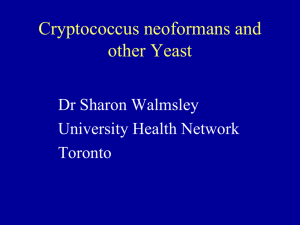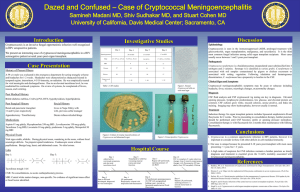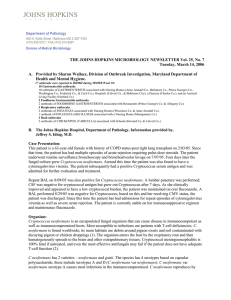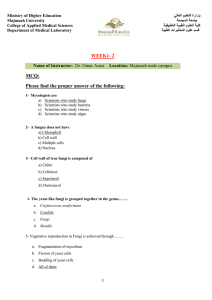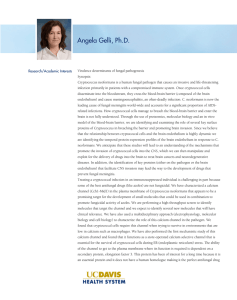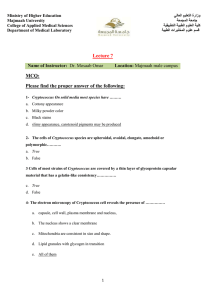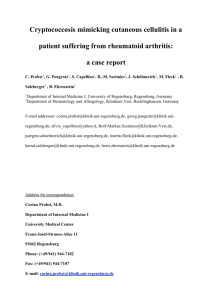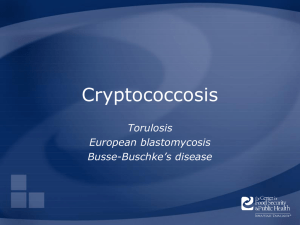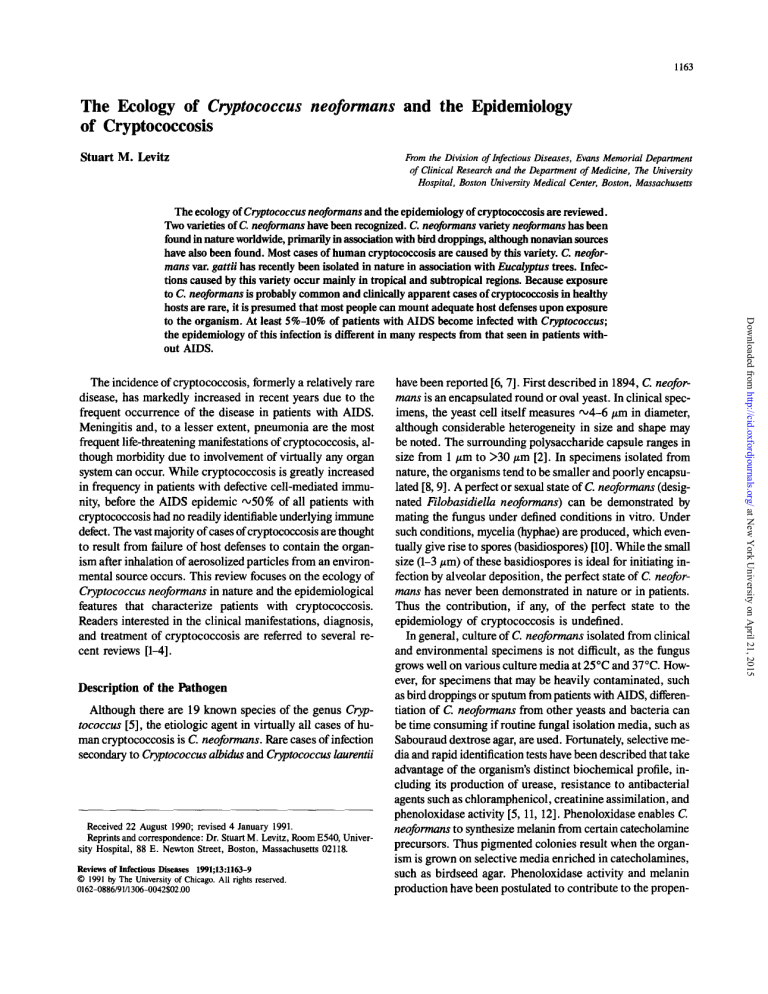
1163 The Ecology of Cryptococcus neoformans and the Epidemiology of Cryptococcosis Stuart M. Levitz From the Division of Infectious Diseases, Evans Memorial Department of Clinical Research and the Department of Medicine, The University Hospital, Boston University Medical Center, Boston, Massachusetts The incidence of cryptococcosis, formerly a relatively rare disease, has markedly increased in recent years due to the frequent occurrence of the disease in patients with AIDS. Meningitis and, to a lesser extent, pneumonia are the most frequent life-threatening manifestations of cryptococcosis, although morbidity due to involvement of virtually any organ system can occur. While cryptococcosis is greatly increased in frequency in patients with defective cell-mediated immunity, before the AIDS epidemic f\J50% of all patients with cryptococcosis had no readily identifiable underlying immune defect. The vast majority ofcases of cryptococcosis are thought to result from failure of host defenses to contain the organism after inhalation of aerosolized particles from an environmental source occurs. This review focuses on the ecology of Cryptococcus neoformans in nature and the epidemiological features that characterize patients with cryptococcosis. Readers interested in the clinical manifestations, diagnosis, and treatment of cryptococcosis are referred to several recent reviews [1-4]. Description of the Pathogen Although there are 19 known species of the genus Cryptococcus [5], the etiologic agent in virtually all cases of human cryptococcosis is C. neoformans. Rare cases of infection secondary to Cryptococcus albidus and Cryptococcus laurentii Received 22 August 1990; revised 4 January 1991. Reprints and correspondence: Dr. Stuart M. Levitz, Room E540, University Hospital, 88 E. Newton Street, Boston, Massachusetts 02118. Reviews of Infectious Diseases 1991;13:1163-9 © 1991 by The University of Chicago. All rights reserved. 0162-0886/91/1306-0042$02 .00 have been reported [6, 7]. First described in 1894, C. neoformans is an encapsulated round or oval yeast. In clinical specimens, the yeast cell itself measures f\J4-6 #Lm in diameter, although considerable heterogeneity in size and shape may be noted. The surrounding polysaccharide capsule ranges in size from 1 #Lm to >30 #Lm [2]. In specimens isolated from nature, the organisms tend to be smaller and poorly encapsulated [8, 9]. A perfect or sexual state of C. neoformans (designated Filobasidiella neoformans) can be demonstrated by mating the fungus under defined conditions in vitro. Under such conditions, mycelia (hyphae) are produced, which eventually give rise to spores (basidiospores) [10]. While the small size (1-3 #Lm) of these basidiospores is ideal for initiating infection by alveolar deposition, the perfect state of C. neoformans has never been demonstrated in nature or in patients. Thus the contribution, if any, of the perfect state to the epidemiology of cryptococcosis is undefined. In general, culture of C. neoformans isolated from clinical and environmental specimens is not difficult, as the fungus grows well on various culture media at 25°C and 37°C. However, for specimens that may be heavily contaminated, such as bird droppings or sputum from patients with AIDS, differentiation of C. neoformans from other yeasts and bacteria can be time consuming if routine fungal isolation media, such as Sabouraud dextrose agar, are used. Fortunately, selective media and rapid identification tests have been described that take advantage of the organism's distinct biochemical profile, including its production of urease, resistance to antibacterial agents such as chloramphenicol, creatinine assimilation, and phenoloxidase activity [5, 11, 12]. Phenoloxidase enables C. neoformans to synthesize melanin from certain catecholamine precursors. Thus pigmented colonies result when the organism is grown on selective media enriched in catecholamines, such as birdseed agar. Phenoloxidase activity and melanin production have been postulated to contribute to the propen- Downloaded from http://cid.oxfordjournals.org/ at New York University on April 21, 2015 The ecology of Cryptococcus neoformans and the epidemiology of cryptococcosis are reviewed. Two varieties of C. neojormans have been recognized. C. neojormans variety neojormans has been found in nature worldwide,primarily in association with bird droppings, although nonavian sources have also been found. Most cases of human cryptococcosis are caused by this variety. C. neojormans var. gattii has recently been isolated in nature in association with Eucalyptus trees. Infections caused by this variety occur mainly in tropical and subtropical regions. Because exposure to C. neoformans is probably common and clinically apparent cases of cryptococcosis in healthy hosts are rare, it is presumed that most people can mount adequate host defenses upon exposure to the organism. At least 5%-10% of patients with AIDS become infected with Cryptococcus; the epidemiology of this infection is different in many respects from that seen in patients without AIDS. 1164 Levitz RID 1991;13 (November-December) In contrast to the situation with pigeon droppings, a lower percentage of soil samples are positive for C. neoformans, the concentration of organisms in soil tends to be less, and positivesamplesare often obtained from areas contaminated by bird excreta. For instance, in a survey of 1,127 soil samples collected from differentgeographic areas of the world, only 14 (1 %) were positive for C. neoformans. Of those, 10 were from areas frequented by chickens and pigeons [34]. It has been suggested that soil formsan inhospitable environment for C. neoformans. In supportof this, anaerobic conditions,hightemperatures, decreased humidity, direct sunshine, low pH, and the presence of soil amebae (which devour the fungi) andother microbes have all beenshownto be detrimental to the survival of C. neoformans in soil [33, 35, 36]. C. neoformans has been isolated from the excrementof a variety of avian species in addition to pigeons, including chickens, parrots, sparrows, starlings, turtledoves, canaries, and skylarks [30, 37-39]. The reason for the high frequency of C. neoformans in avian excreta is not clear but may be relatedto the ability of the fungito assimilatexanthine,urea, uric acid, andcreatinine, all of whichare abundant in thedroppings [37]. As alluded to earlier, C. neoformans is occasionally isolated fromvariousnonaviansources, including fruits, vegetables, dairy products, and the digestive tract of the cockroach [23, 24, 40,41]. In a study of440 fruit and vegetablesamples taken from a market in Delhi, India, five (1 %) of the samples (oneeachof apple, guava,papaya, carrot, and potato) yielded C. neoformans [40]. Thus far, all isolatescollected from bird droppings, soil, fruits, vegetables, and milk, whentested,have been C. neoformans var. neoformans [5, 31, 42]. In a unique study, C. neoformans was isolated from bagpipes used by a patient with pulmonary cryptococcosis. However, it is plausiblethatthe patient's sputumcontaminated the bagpipes [43]. Distribution in Nature of C neoformans var. neoformans Distribution in Nature of C neoformans yare gattii C. neoformans wasisolated in nature first from peachjuice in 1895 and then from milk in 1901 [5, 23, 24]. It was not isolated again from a saprophytic source until Emmons [25, 26] isolated the organismfrom soil in 1951 and from pigeon excreta in 1955. Although pigeon droppings commonly are colonized with C. neoformans, pigeons do not appear to become sick due to cryptococcosis, perhaps becausetheir high body temperature is detrimental to growth of the organism [26]. SinceEmmons's originalreports, C. neoformans has been isolated from soil, pigeonexcrement,and sitescontaminated by pigeon excrement in various parts of the world. Concentrations of C. neoformans in pigeon droppings often exceed 1Q6 viable organisms per gram, and most investigators have encountered little difficulty isolating C. neoformans directly from pigeonexcretaor samplescontaminated by suchexcreta [27-33]. As opposed to C. neoformans var. neoformans (serotypes A and D), whose isolation has been reported from numerous environmental sources worldwide, C. neoformans var. gattii (serotypesB and C) has been considerably more difficult to isolate from the environment. An isolate obtained from soil samples and reported as serotypeC [31] provedsubsequently to be serotype A [17]. Recently, Ellis and Pfeiffer [44, 45] extensively tested environmentalsamples from sites in rural Australia, an area in which C. neoformans var. gattii is endemic. This organismwas isolatedexclusively from material (including bark, wood, and leaves) collectedunder the canopies of Eucalyptus camaldulensis (river red gum) trees. The time at which the positive cultures were obtained coincided with the flowering of the trees. Moreover, air-sampling experimentsdetected airborne fungus in the vicinity of flowering trees but not of nonflowering trees or in other areas. The distribution of E. camaldulensis is concentrated in trop- Downloaded from http://cid.oxfordjournals.org/ at New York University on April 21, 2015 sity for C. neoformans to invade the CNS, an area rich in catecholamines [13]. Rareisolatesof urease-negative C. neoformans have been described [14]. On the basis of antigenic determinants on the polysaccharide capsule, four serotypes (A, B, C, and D) of C. neoformans have been recognized; the structures of the major capsular polysaccharides of these serotypes havebeen determined [15]. Type-specific antiserum used for serotyping is prepared by immunizing rabbits with formalin-killed yeasts of a known serotype and then adsorbing the antiserum with yeastsof heterologous serotypes[16]. Occasional clinicalisolates of C. neoformans are untypeable on the basis of their failure to agglutinate on exposure to one of the four typespecificantisera [17]. Someisolatesreact to bothtypes A and D antisera and are designated AD [16]. Individual isolates of C. neoformans canbe distinguishedby their pattern shown by pulsed-field gelelectrophoresis, a technique thatmayprove powerful in studying the molecular epidemiology of cryptococcosis [18]. Geneticand biochemicalstudieshaveestablishedtwovarieties of C. neoformans. C. neoformans var. neoformans includes serotypes A and D, while C. neoformans var. gattii includes serotypesBand C. In addition to serotyping, which requires special reagents, the color reaction on various solid media can be used to distinguishthe twovarietieswith a high degree of accuracy; these media include creatinine-dextrosebromthymolblue (CDB)agar, canavanine-glycine-bromthymol blue (CGB) agar, and glycine-cyclohexamide-phenol red (GCP) agar [19-22]. Moreover, C. neoformans var. gattii assimilates L-malate and is relatively temperature sensitive [5, 10]. The morphology of the perfect states of the twovarieties is also different[10]. As discussed in detail later, distinctive featurescharacterizethe epidemiologyand ecologyof the individual varieties and serotypes of C. neoformans. RID 1991;13 (November-December) Cryptococcosis ical and subtropical regions; these regions correspond to the areas of the world in which clinically apparent infections due to C. neoformans var. gattii are endemic (see next section). Future studies are needed to determine whether C. neoformans var. gattii is host-specific for E. camaldulensis or whether other species of Eucalyptus and related plants also harbor the fungus. It is noteworthy that in California alone rv150 speciesof Eucalyptus, includingE. camaldulensis, have been cultivated [46, 47]. Epidemiology of Cryptococcal Varieties and Serotypes in Patients with Cryptococcosis There are few published data comparing clinical features of patients infected with the two varieties of C. neoformans. In a study published in abstract form only, Henderson et al. [59]compared nine patientswith cryptococcal meningitis due to C. neoformans var. gattii with a matched group of patients infected with C. neoformans var. neoformans. None had severeunderlying immunosuppression. The group infectedwith C. neoformans var. gattii required a longer course of chemotherapy, leadingthe authorsto speculatethat meningitis caused by that variety might be more refractory. It has been suggested that C. neoformans var. gattii has a relativepredilection for healthyhosts and C. neoformans var. neoformans for compromised hosts [2]. Two studies examined the in vitro susceptibilities of the two varieties to commonly used antifungal drugs. One found no significant differences in susceptibilities, while the other found diminishedsensitivityto 5-fluorocytosine in C. neoformans var. gattii [51, 60]. Epidemiological Characteristics of Patients Infected with C. neoformans Since C. neoformans is ubiquitous in the environment, exposure to the fungus presumably is commonplace. Few epidemiological studiesattempting to prove this assumption have been performed. For the most part, these studies consisted of skin-test surveys using cryptococcin, an antigenic extract of C. neoformans [61-63]. Results are somewhat difficultto interpret because the cryptococcin skin test has not beenstandardized, the antigens in the extract are incompletely characterized, and the sensitivity and specificity of the test are unknown. In a study of 28 pigeon breeders, results for nine (32%) of 28 who underwent a cryptococcin skin test were positive, although for none of those tested was there clinical evidence of past or present infection. In contrast, only one (4%) of a control group of 24 tested positive [62]. Pigeon handlers also have a high frequency of cryptococcal antibodies in serum [64, 65]. An increased incidence of reactivity to cryptococcin among laboratory personnel who work with C. neoformans has been noted [63]. Despite these findings, which suggest that exposure to C. neoformans is particularly common in certain groups such as pigeon breeders and laboratory workers, there is no evidence of an increased incidence of active cryptococcosis among these groups. Unlike outbreaks of other systemicmycoses, outbreaks of cryptococcosis traced to environmental sources have not been described. Scattered cases tend to occur worldwide, althougha uniquereport describedthree cases of cryptococcosis occurring within a IS-month period in the small town of Kingfisher, Oklahoma [30]. Another case report described pulmonary and hepatic cryptococcosis in a patient who trapped wild pigeons in a building contaminated with pigeon droppings containing C. neoformans [29]. Because nearly everybody is exposed to birds and bird excreta, Downloaded from http://cid.oxfordjournals.org/ at New York University on April 21, 2015 Kwon-Chung and Bennett [17] reported the varieties and serotypes of725 clinical isolates of C. neoformans from various parts of the world. Although clinical features of the patients were not given, most isolates were apparently collected from patients without AIDS. Isolates from regions with temperate climates such as the United States (excluding Southern California andHawaii), Europe, andJapanbelongednearly exclusivelyto C. neoformans var. neoformans (serotypes A and D). In contrast, there was a high frequency (35%-100%) of C. neoformans var. gattii (serotypes B and C) in isolates from tropicaland subtropicalregionssuchas SouthernCalifornia, Australia, Southeast Asia, Brazil, and Central Africa. As discussed, the presence of C. neoformans var. gattii predominantly in tropical and subtropical regions may be a consequence of the association of this variety with E. camaldulensis trees, as such trees are not found in temperate climates [44, 46]. Overall,of the isolates studiedby Kwon-Chung and Bennett, 70% were serotype A, 16% serotype D or AD, 11 % serotype B, 2 % serotype C, and 1% untypeable. Serotype D was relatively more common in Europe, while nearly all the serotype C isolates were from Southern California. Other investigators, studying smaller numbers of clinical isolates, have reported similar trends [22, 48-52]. Even in areas where a relatively high percentage of clinical isolates from patientswithout AIDS havebeen C. neoformans var. gattii, nearly all of the isolates from patients with AIDS have been C. neoformans var. neoformans [49, 50, 53-55]. As of this writing, only four (of >150 tested) isolates from patients with AIDS reported in the literature were C. neoformans var. gattii [49,50, 53-58]. The reason for this disparity between isolates from patients with and without AIDS is speculativebut likely relates to differencesin the pathogenicity or ecology of the isolates. For instance, in Australia 90 % of patients with AIDS live in a region of the country where E. camaldulensis trees, a natural reservoir for C. neoformans var. gattii, are rarely found [44,45]. Thus, if one postulates that C. neoformans var. gattii is more pathogenic but that exposure to C. neoformans var. neoformans is more common, one would expect the percentage of cases due to C. neoformans var. neoformans to be higher among patients who are severely immunocompromised, such as those with AIDS. 1165 1166 Levitz been termed signal disease, or malade signal, because it may herald the presence of an underlying debilitating disease [5]. Those at particularly high risk havedefects in the cell-mediated arm of the immune system, such as occur in patients with AIDS, Hodgkin's and non-Hodgkin's lymphomas, and sarcoidosis and in those receiving immunosuppressive therapy (especially with glucocorticoids) [1, 2, 4, 37, 75, 76]. The high frequency of cryptococcosis among transplant recipients is probably related to the immunosuppressive therapy given to prevent rejection rather than a direct effect of the transplant itself. It is interesting that cyclosporine, which depresses T cell responses and is used to prevent transplant rejection, has been shown to have intrinsic anticryptococcal activity in some systems and may protect against development of active clinical infection [77]. Cryptococcosis also appears to occur with increased frequency in association with leukopenia, diabetes mellitus, rheumatoid arthritis, and hepatic cirrhosis [1, 2,37, 75, 76]. Before the AIDS epidemic, f\J50 % of cases of cryptococcosis occurred in patients without any obvious immune defects [37, 75, 76], although some may have had subtle defects in their ability to mount an immune response to cryptococcal antigens [78-80]. In several (but not all) series from the pre-AIDS era, cryptococcosis occurred two to three times more often in men than in women [75, 76, 81-83]. Estrogens, which have been shown to have in vitro activity against C. neoformans, may be protective in women [84]; alternatively, however, men may be more likely to be exposed to the fungus. Among patients with AIDS in the United States, approximately equal percentages of each sex are infected with Cryptococcus [85]. Cryptococcosis in patients with AIDS occurs with increased frequency among blacks, intravenous drug users, and residents of the southern states immediately east of the Mississippi River [85, 86]. About 5 %-10% of patients with AIDS in the United States are reportedly stricken with cryptococcosis, making it one of the most common life-threatening infections seen in this group of patients [4, 85]. However, this figure is probably an underestimate of the true incidence, as infections subsequent to the AIDS-defining infection often are not reported to public health departments. Moreover, because signs and symptoms of cryptococcosis can be subtle in cases of AIDS, the infection may not be diagnosed. It will be important to see whether the incidence of cryptococcosis in patients with AIDS increases as patients live longer due to the availability of primary therapy for the human immunodeficiency virus and prophylactic therapy for infection due to Pneumocystis carinii. The prevalence of cryptococcosis in patients with AIDS in Africa and other developing areas appears to be higher than that in the United States [87-89]. It is unclear whether this circumstance is secondary to increased exposure to saprophytic sources of the fungus [41, 90] or the relative Downloaded from http://cid.oxfordjournals.org/ at New York University on April 21, 2015 it has been difficult to implicate or exonerate the bird as the main vector responsible for transmission of C. neoformans var. neoformans, and the possibility remains that at least some patients acquire infection due to this organism from nonavian sources that remain unrecognized. Since exposure to C. neoformans is probably common but clinically apparent cases of cryptococcosis are rare, it is presumed that most people can mount adequate host defenses when exposed to the organism. Although it has never been conclusively documented, virtually all cases of cryptococcosis are thought to result initially from inhalation of airborne fungi from an environmental source. Isolates of C. neoformans measuring 0.6-3.5 Itm in diameter, a size ideal for alveolar deposition after inhalation, have been isolated from aerosols generated from soil and pigeon droppings [8, 33, 66]. Samples of air obtained under flowering E. camaldulensis trees also have grown C. neoformans [44, 45]. Moreover, small pulmonary lesions, consistent with clinically unapparent primary cryptococcosis, have been incidentally noted in human pathology specimens [3, 67]. The human tracheobronchial tree may become colonized with C. neoformans, presumably after inhalation of airborne organisms, without development of active cryptococcosis [68, 69]. Rare cases of cutaneous cryptococcosis have occurred after direct inoculation of the organism into the skin [70, 71]. However, most cases of cutaneous cryptococcosis result from hematogenous dissemination from systemic disease. Although never documented, the possibility exists that some cases of cryptococcosis could be the result of dissemination from a gastrointestinal portal of entry. The occasional findings of contamination of food and human stool with C. neoformans [2, 23, 24, 40, 72] lend support to this possibility. Moreover, in animal models, disseminated cryptococcosis may be seen after gastrointestinal inoculation of C. neoformans [73]. Two unusual cases of presumed person-to-person transmission of cryptococcosis have been documented. In the first case, a recipient of a corneal transplant from a donor with cryptococcosis developed cryptococcal endophthalmitis after the transplant [74]. The other case involved a health care worker who developed localized cutaneous cryptococcosis after accidentally inoculating himself with blood from a patient with cryptococcemia [70]. Special precautions, such as isolating infected patients or wearing masks, are not indicated solely on the basis of a diagnosis of cryptococcosis, although it would probably be prudent for patients who are severely immunocompromised to avoid contact with patients who are coughing and whose sputum is positive for C. neoformans. Veterinary cases of cryptococcosis occur, but animal-to-person transmission has never been reported. The prevalence of cryptococcosis is markedly increased among immunocompromised patients. Moreover, the morbidity, mortality, and frequency of relapse are higher in those who are severely immunocompromised. Cryptococcosis has RID 1991;13 (November-December) RID 1991;13 (November-December) Cryptococcosis Note Added in Proof Sincethis articlewasaccepted for publication, C. neoformans var. gattiihasbeen isolated from E. camaldulensis trees in California[93]. References 1. Diamond RD. Cryptococcus neoformans. In: Mandell GL, Douglas RG Jr, Bennett IE, eds. Principles and practice of infectious diseases. 3rd ed. New York: Churchill Livingstone, 1990;1980-9 2. Perfect JR. Cryptococcosis. Infect Dis Clin North Am 1989;3:77-102 3. Diamond RD, Levitz SM. Cryptococcus neoformans pneumonia. In: Pennington JE, ed. Respiratory infections: diagnosis and management. 2nd ed. New York: Raven Press, 1988:457-71 4. Dismukes WE. Cryptococcal meningitis in patients with AIDS. J Infect Dis 1988;157:624-8 5. Rippon JW. Medical mycology. The pathogenic fungi and the pathogenic actinomycetes. 3rd ed. Philadelphia: W. B. Saunders, 1988: 582-609 6. Krumholz RA. Pulmonary cryptococcosis. A case due to Cryptococcus albidus. Am Rev Respir Dis 1972;105:421-4 7. Lynch JP III, Schaberg DR, Kissner DG, Kauffman CA. Cryptococcus laurentii lung abscess. Am Rev Respir Dis 1981;123:135-8 8. Neilson JB, Fromtling RA, Bulmer GS. Cryptococcus neoformans: size range of infectious particles from aerosolized soil. Infect Immun 1977;17:634-8 9. Farhi F, Bulmer GS, Thcker JR. Cryptococcus neoformans. IV. The notso-encapsulated yeast. Infect Immun 1970;1:526-31 10. Kwon-Chung KJ, Bennett JE, Rhodes JC. Taxonomic studies on Filobasidiella species and their anamorphs. Antonie van Leeuwenhoek 1982;48:25-38 11. Cooper BH, Silva-Hutner M. Yeasts of medical importance. In: Lennette EH, ed. Manual of clinical microbiology. 4th ed. Washington, DC: American Society for Microbiology, 1985;526-41 12. Staib F, Seibold M, Antweiler E, Frohlich B. Staib agar supplemented with a triple antibiotic combination for the detection of Cryptococcus neoformans in clinical specimens. Mycoses 1989;32:448-54 13. Rhodes JC, Polacheck I, Kwon-Chung KJ. Phenoloxidase activity and virulence in isogenic strains of Cryptococcus neoformans. Infect Immun 1982;36:1175-84 14. Ruane PJ, Walker U, George WL. Disseminated infection caused by urease-negative Cryptococcus neoformans. J Clin MicrobioI1988;26: 2224-5 15. Bhattacharjee AK, Bennett JE, Glaudemans CPJ. Capsular polysaccharides of Cryptococcus neoformans. Rev Infect Dis 1984;6:619-24 16. Wilson DE, Bennett IE, Bailey JW. Serologic grouping of Cryptococcus neoformans. Proc Soc Exp BioI Med 1968;127:820-3 17. Kwon-Chung KJ, Bennett JE. Epidemiologic differences between the two varieties of Cryptococcus neoformans. Am J Epidemiol 1984;120: 123-40 18. Perfect JR, Magee BB, Magee PT. Separation of chromosomes of Cryptococcus neoformans by pulsed field gel electrophoresis. Infect Immun 1989;57:2624-7 19. Kwon-Chung KJ, Polachek I, BennettJE. Improved diagnostic medium for separation of Cryptococcus neoformans var. neoformans (serotypes A and D) and Cryptococcus neoformans var. gattii (serotypes B and C). J Clin Microbiol 1982;15:535-7 20. Salkin IF, Hurd NJ. New medium for differentiation of Cryptococcus neoformans serotype pairs. J Clin Microbiol 1982;15:169-71 21. Min KH, Kwon-Chung KJ. The biochemical basis for the distinction between the two Cryptococcus neoformans varieties with CGB medium. Zentralbl Bakteriol Mikrobiol Hyg [A] 1986;261:471-80 22. Swinne D. Study of Cryptococcus neoformans varieties. Mykosen 1984;27:137-41 23. Sanfelice F. Uber einen neuen pathogenen Blastomyceten, welcher innerhalb de Gewebe unter Bidung Kalkartig aussenhender Massendegerenert. Int J Med Microbiol 1895;18:521-6 24. Klein E. Pathogenic microbes in milk. Journal of Hygiene (Cambridge) 1901;1:78-95 25. Emmons CWo Isolation of Cryptococcus neoformans from soil. J Bacteriol 1951;62:685-90 26. Emmons CWo Saprophyticsourcesof Cryptococcus neoformans associated with the pigeon (Columba Livia). Am J Hyg 1955;62:227-32 27. Littman ML, Schneierson SS. Cryptococcus neoformans in pigeon excreta in New York City. Am J Hyg 1959;69:49-59 28. Emmons CWo Prevalenceof Cryptococcus neoformans in pigeon habitats. Public Health Rep 1960;75:362-4 29. Procknow 11, Benfield JR, Rippon JW, Diener CF, Archer FL. Cryptococcal hepatitis presenting as a surgical emergency. First isolation of Cryptococcus neoformans from a point source in Chicago. JAMA 1965;191:269-74 30. Muchmore HG, Rhoades ER, Nix GE, Felton FG, Carpenter RE. Occurrence of Cryptococcus neoformans in the environmentof three geographically associated cases of cryptococcal meningitis. N Engl J Med 1963;268: 1112-4 31. Denton JF, DiSalvo AF. The prevalence of Cryptococcus neoformans in various natural habitats. Sabouraudia 1968;6:213-7 32. Littman ML, Borok R. Relation of the pigeon to cryptococcosis: natural carrier state, heat resistance and survival of Cryptococcus neoformans. Mycopathologia 1968;35:329-45 33. Ruiz A, Fromtling RA, Bulmer GS. Distribution of Cryptococcus neoformans in a natural site. Infect Irnmun 1981;31:560-3 Downloaded from http://cid.oxfordjournals.org/ at New York University on April 21, 2015 rarity of other AIDS-related infections, in particular those caused by P. carinii and the Mycobacterium avium complex, in those parts of the world [91, 92]. Because patients with AIDS are so exquisitely susceptible to infection with Cryptococcus it would appear to make empiric sense to counsel them to avoid situations in which exposure to heavy aerosols of C. neoformans might be likely, such as sweeping a floor contaminated with pigeon droppings or being in the vicinity of a flowering Eucalyptus tree. However, because of the ubiquity of C. neoformans and the fact that our knowledge of the circumstances that result in inoculation of the organism is incomplete, it is uncertain whether such precautions would be beneficial. Moreover, some cases might arise from reactivation from a latent focus, as has been shown for other mycoses such as histoplasmosis and coccidioidomycosis. Alternative approaches for the prevention or early detection of cryptococcosis in patients with AIDS that merit consideration include prophylaxis with antifungal drugs and periodic screening for cryptococcal antigen. Thus, since C. neoformans was first isolated from clinical and ecologic sources nearly a century ago, knowledge of its ecology and epidemiology has greatly expanded. However, despite these significant advances, much still needs to be learned regarding the circumstances under which patients become infected with this ubiquitous fungus. The challenge ahead will be to apply this wisdom towards strategies for reducing the occurrence of cryptococcosis. 1167 1168 RID 1991;13 (November-December) 59. Henderson DK, Edwards JE, Dismukes WE, Bennett JE. Meningitis produced by different serotypes of Cryptococcus neoformans [abstract]. In: Proceedings of the annual meeting of the American Society for Microbiology. Washington, DC: American Society for Microbiology, 1981 60. Fromtling RA, Abruzzo GK, Bulmer GS. Cryptococcus neoformans: comparisons of in vitro antifungal susceptibilities of serotypes AD and Be. Mycopathologia 1986;94:27-30 61. Bennett JE. Cryptococcal skin test antigen: preparation variables and characterization. Infect Immun 1981;32:373-80 62. Newberry WM Jr, Walter JE, Chandler JW Jr, Tosh FE. Epidemiologic study of Cryptococcus neoformans. Ann Intern Med 1967;67:724-32 63. Atkinson AJ Jr, Bennett JE. Experience with a new skin test antigen prepared from Cryptococcus neoformans. Am Rev Respir Dis 1968; 97:637-43 64. Walter JE, Atchison RW. Epidemiological and immunological studies of Cryptococcus neoformans. J Bacteriol 1966;92:82-7 65. Fink IN, Barboriak JJ, Kaufman L. Cryptococcal antibodies in pigeon breeders' disease. J Allergy Clin Immunol 1968;41:297-301 66. Powell KE, Dahl BA, Weeks RJ, Tosh FE. Airborne Cryptococcus neoformans: particles from pigeon excreta compatible with alveolar deposition. J Infect Dis 1972;125:412-5 67. McDonnell JM, Hutchins GM. Pulmonary cryptococcosis. Hum Pathol 1985;16:121-8 68. Hammerman KJ, Powell KE, Christianson CS, Huggin PM, Larsh HW, Vivas JR, Tosh FE. Pulmonary cryptococcosis: clinical forms and treatment. A Centers for Disease Control cooperative mycoses study. Am Rev Respir Dis 1973;108:1116-23 69. Howard DH. The commensalism of Cryptococcus neoformans. Sabouraudia 1973;11:171-4 70. Glaser JB, Garden A. Inoculation of cryptococcosis without transmission of the acquired immunodeficiency syndrome [letter]. N Engl J Med 1985;313:264 71. Shuttleworth D, Philpot CM, Knight AG. Cutaneous cryptococcosis: treatment with oral fluconazole. Br J Dermatol 1989;120:683-7 72. Emmons CW, Binford CH, Utz JP, Kwon-Chung KJ. Medical mycology. 3rd ed. Philadelphia: Lea & Febiger, 1977:227 73. Green JR, Bulmer GS. Gastrointestinal inoculation of Cryptococcus neoformans in mice. Sabouraudia 1979;17:233-40 74. Beyt BE Jr, Waltman SR. Cryptococcal endophthalmitis after corneal transplantation. N Engl J Med 1978;298:825-6 75. Butler WT, Alling DW, Spickard A, Utz JP. Diagnostic and prognostic value of clinical and laboratory findings in cryptococcal meningitis. N Engl J Med 1964;270:59-67 76. Lewis JL, Rabinovich S. The wide spectrum of cryptococcal infections. Am J Med 1972;53:315-22 77. Mody CH, Toews GB, Lipscomb MF. Cyclosporin A inhibits the growth of Cryptococcus neoformans in a murine model. Infect Immun 1988;56:7-12 78. Graybill JR, Alford RH. Cell-mediated immunity in cryptococcosis. Cell Immunol 1974;14:12-21 79. Schimpff SC, Bennett JE. Abnormalities in cell-mediated immunity in patients with Cryptococcus neoformans infection. J Allergy Clin ImmunoI1975;55:430-41 80. Henderson DK, Bennett JE, Huber MA. Long-lasting, specific immunologic unresponsiveness associated with cryptococcal meningitis. J Clin Invest 1982;69:1185-90 81. Sarosi GA, Parker JD, Doto IL, Tosh FE. Amphotericin B in cryptococcal meningitis: long-term results of treatment. Ann Intern Med 1969;71: 1079-87 82. Mosberg WH Jr, Arnold JG Jr. Torulosis of the central nervous system: review of literature and report of five cases. Ann Intern Med 1950;32:1153-83 83. Luchi MJ, Di Bona D, Popma G, Munford RS, Haley RW. Urban cryp- Downloaded from http://cid.oxfordjournals.org/ at New York University on April 21, 2015 34. Ajello L. Occurrence of Cryptococcus neoformans in soils. Am J Hyg 1958;67:72-7 35. Ishaq CM, Bulmer GS, Felton FG. An evaluation of various environmental factors affecting the propagation of Cryptococcus neoformans. Mycopathologia 1968;35:81-90 36. Bunting LA, Neilson JB, Bulmer GS. Cryptococcus neoformans: gastronomic delight of a soil ameba. Sabouraudia 1979;17:225-32 37. Littman ML, Walter JE. Cryptococcosis: current status. Am J Med 1968;45 :922-32 38. Bauwens L, Swinne D, DeVroey C, DeMeurichy W. Isolation of Cryptococcusneoformans var. neoformans in the aviaries of the Antwerp Zoological Gardens. Mykosen 1986;29:291-4 39. DeVroey C, Swinne D. Isolements de Cryptococcus neoformans a Foecasion de concours de chant de canaris (+). Bull Soc Fr Mycol Med 1986;15:353-6 40. Pal M, Mehrotra BS. Studies on the isolation of Cryptococcus neoformans from fruits and vegetables. Mykosen 1984;28:200-5 41. Swinne D, Kayembe K, Niyimi M. Isolation of saprophytic Cryptococcus neoformans var. neoformans in Kinshasa, zaire. Ann Soc Belg Med Trop 1986;66:57-61 42. Ruiz A, Velez D, Fromtling RA. Isolation of saprophytic Cryptococcus neoformans from Puerto Rico: distribution and variety. Mycopathologia 1989;106:167-70 43. Cobcroft R, Kronenberg H, Wilkinson T. Cryptococcus in bagpipes [letter]. Lancet 1978;1:1368-9 44. Ellis DH, Pfeiffer TJ. Natural habitat of Cryptococcus neoformans var. gattii. J Clin Microbiol 1990;28:1642-4 45. Ellis DH, Pfeiffer TJ. Ecology, life cycle, and infectious propagule of Cryptococcus neoformans. Lancet 1990;336:923-5 46. McClatchie AJ. Eucalyptus cultivated in the United States. USDA Forestry Bulletin no. 35. Washington, DC: Government Printing Office, 1902 47. Muller KK, Broder RE, Beittel W. Trees of Santa Barbara. Santa Barbara, CA: Santa Barbara Botanic Garden, 1974 48. Ellis DH. Cryptococcus neoformans var. gattii in Australia. J Clin Microbiol 1987;25 :430-1 49. St-Germain-G, Auger P, Lemieux C. Cryptococcus neoformans in Quebec (1985-1986). Mycoses 1988;31:123-8 50. Swinne D, Nkurikiyinfura JB, Muyembe TL. Clinical isolates of Cryptococcus neoformans from zaire. Eur J Clin MicrobioI1986;5:50-1 51. Shadomy HJ, Wood-Helie S, Shadomy S, Dismukes WE, Chau RY, NIAID Mycoses Study Group. Biochemical serogrouping of clinical isolates of Cryptococcus neoformans. Diagn Microbiol Infect Dis 1987;6:131-8 52. Walter JE, Coffee EG. Distribution and epidemiologic significance of the serotypes of Cryptococcus neoformans. Am J Epidemiol1968; 87:167-72 53. Rinaldi MG, Drutz DJ, Howell A, Sande MA, Wofsy CB, Hadley WK. Serotypes of Cryptococcus neoformans in patients with AIDS [letter]. J Infect Dis 1986;153:642 54. Shimizu RY, Howard DH, Clancy MN. The variety of Cryptococcus neoformansui patients with AIDS [letter]. JInfect Dis 1986;154:1042 55. Bottone EJ, Salkin IF, Hurd NJ, Wormser GP. Serogroup distribution of Cryptococcus neoformans in patients with AIDS [letter]. J Infect Dis 1987;156:242 56. St-Germain G, Noel G, Kwon-Chung KJ. Disseminated cryptococcosis due to Cryptococcus neoformans variety gattii in a Canadian patient with AIDS [letter]. Eur J Clin Microbiol Infect Dis 1988;7:587-8 57. Clancy MN, Fleischmann J, Howard DH, Kwon-Chung KJ, Shimizu RY. Isolation of Cryptococcus neoformans gattii from a patient with AIDS in Southern California [letter]. J Infect Dis 1990;161:809 58. Rozenbaum R, Goncalves AJR, Wanke B, Vieira W. Cryptococcus neoformans var. gattii in a Brazilian AIDS patient. Mycopathologia 1990;112:33-4 Levitz RID 1991;13 (November-December) 84. 85. 86. tococcal disease in the pre-AIDS era [abstract]. In: Program and Abstracts of the 29th Interscience Conference on Antimicrobial Agents and Chemotherapy. Washington, DC: American Society for Microbiology, 1989 Mohr JA, Long H, McKown BA, Muchmore HG. In vitro susceptibility of Cryptococcus neoformansto steroids. Sabouraudia 1972;10:171-2 Horsburgh CR Jr, Selik RM. Extrapulmonary cryptococcosis in AIDS patients: risk factors and association with decreased survival [abstract]. In: Program and abstracts of the 28th Interscience Conference on Antimicrobial Agents and Chemotherapy. Washington, DC: American Society for Microbiology, 1988 Castro KG, Selik RM, Jaffe HW, Dondero TJ, Curran JW. Frequency of opportunistic diseases in AIDS patients, by race/ethnicity and HIV transmission categories- United States [abstract]. In: Program and abstracts of the 28th Interscience Conference on Antimicrobial Agents and Chemotherapy. Washington, DC: American Society for Microbiology, 1988 Piot P, Quinn TC, Taelman H, Feinsod FM, Minlangu KB, Wobin 0, Mbendi N, Mazebo P, Ndangi K, Stevens W, Kalambayi K, Mitchell S, Bridts C, McCormick JB. Acquired immunodeficiency syndrome in a heterosexual population in Zaire. Lancet 1984;2:65-9 1169 88. Clumeck N, Sonnet J, Taelman H, Mascart-Lemone F, DeBruyere M, Vandeperre P, Dasnoy J, Marcelis L, Lamy M, Jonas C, Eyckmans L, Noel H, Vanhaeverbeek M, Butzler J-P. Acquired immunodeficiency syndrome in African patients. N Engl J Med 1984;310:492-7 89. Desmet P, Kayembe KD, DeVroey C. The value of cryptococcal serum antigen screening among HIV-positive/AIDS patients in Kinshasa, Zaire. AIDS 1989;3:77-8 90. Swinne D, Deppner M, Laroche R, Floch J-J, Kadende P. Isolation of Cryptococcus neoformans from houses of AIDS-associated cryptococcosis patients in Bujumbura (Burundi). AIDS 1989;3:389-90 91. Goodgame RW. AIDS in Uganda-clinical and social features. N Engl J Med 1990;323:383-9 92. Okello DO, Sewankambo N, Goodgame R, Aisu TO, Kwezi M, Morrissey A, Ellner JJ. Absence of bacteremia with Mycobacterium aviumintracellulare in Ugandan patients with AIDS. J Infect Dis 1990;162: 208-10 93. Pfeiffer T, Ellis D. Environmental isolation of Cryptococcus neoformans gattii from California. J Infect Dis 1991;163:929-30 Downloaded from http://cid.oxfordjournals.org/ at New York University on April 21, 2015 87. Cryptococcosis
